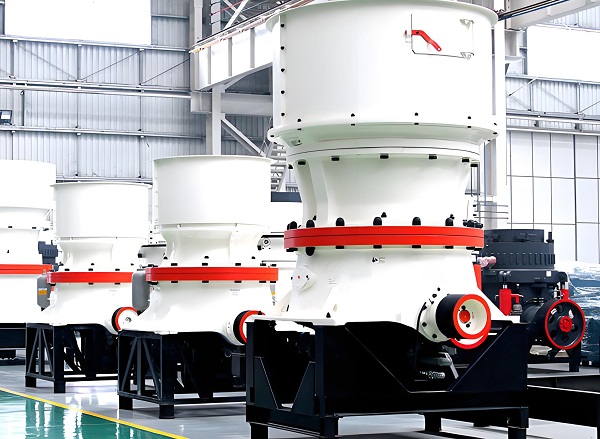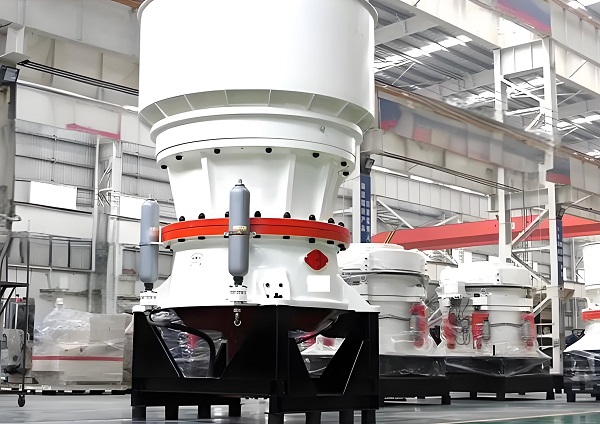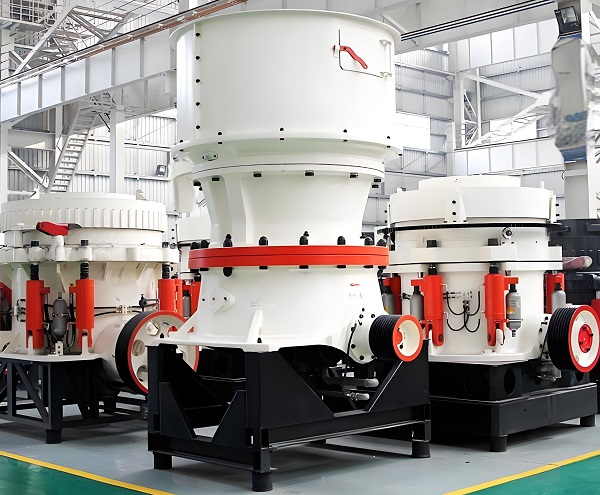Preface: In the modern industrial system, crushing equipment is a basic and key link. Among them, cone crusher occupies a pivotal position in many industries with its unique working principle and excellent performance. This article will deeply analyze the working principle, structural composition, actual function, application field and future development trend of cone crusher to help readers fully understand this key equipment.

Cone Crusher
1. Working principle of cone crusher
When the cone crusher is running, the motor transmits power to the eccentric sleeve through the pulley and the V-belt, causing it to start rotating. Driven by the eccentric sleeve, the moving cone performs a swinging motion, which causes the volume of the crushing chamber between the moving cone and the fixed cone to continuously change. When the moving cone approaches the fixed cone, the material in the crushing chamber will be subjected to strong extrusion, bending and impact at the same time, and then gradually crushed; and when the moving cone leaves the fixed cone, the crushed material is discharged smoothly from the bottom of the crushing chamber under the action of its own gravity. This cycle repeats to achieve continuous crushing of materials.
This unique working mode allows the material to undergo multiple extrusions and crushing during the crushing process, greatly improving the crushing efficiency and ensuring the high quality of the product. Compared with other types of crushers, cone crushers have a larger crushing ratio and can efficiently crush large particles into smaller products, fully meeting the strict requirements of different production processes for material particle size.
2. Cone crusher structure
The cone crusher is mainly composed of key parts such as frame, transmission device, eccentric sleeve, moving cone, fixed cone, adjustment device and safety device.
Frame: As the basic supporting structure of the entire crusher, the frame is subjected to various complex forces during the operation of the equipment, and its stability is directly related to the normal operation of the equipment. Usually, the frame is welded with high-strength cast iron or steel plates, with excellent rigidity and seismic resistance, providing a solid guarantee for the stable operation of the crusher.
Transmission device: The transmission device is responsible for transmitting the power of the motor to the eccentric sleeve, thereby driving the moving cone to perform a rotary swing motion. It generally includes components such as pulleys, V-belts and drive shafts. The rationality of its design has a direct impact on the working efficiency and operating stability of the crusher.
Eccentric sleeve: The eccentric sleeve is the core component for realizing the rotary swing motion of the moving cone. As the eccentric sleeve rotates, the moving cone will produce a complex motion trajectory, thereby completing the crushing of the material. The manufacturing accuracy of the eccentric sleeve and the quality of the selected materials play a vital role in the overall performance of the crusher.
Moving cone and fixed cone: The moving cone and fixed cone are the core crushing components of the crusher, and the crushing chamber formed between the two is the main area for material crushing. In order to extend the service life, the surfaces of the moving cone and the fixed cone are usually made of wear-resistant materials. In the actual crushing process, the gap between the moving cone and the fixed cone can be flexibly adjusted according to production needs to accurately control the particle size of the product.
Adjustment device: The adjustment device is mainly used to adjust the gap between the moving cone and the fixed cone to adapt to the requirements of different material characteristics and production processes. Common adjustment methods are hydraulic and mechanical. These two methods are simple and fast to operate, and can accurately and efficiently complete the gap adjustment work.
Safety device: When the crusher encounters unbreakable materials or overload, the safety device can respond quickly and effectively protect the equipment from damage. Common safety devices include spring safety and hydraulic safety, etc. They play a key role at critical moments to ensure the safe and stable operation of the crusher.

Cone Crusher
3. The role of cone crusher
Improve the uniformity of material particle size: In many industries such as mining, building materials, and metallurgy, large pieces of material need to be crushed into small pieces of material with uniform particle size for subsequent processing and use. The cone crusher can make the particle size distribution of the material more uniform by extruding and crushing the material multiple times, which perfectly meets the strict requirements of the production process for the particle size of the material.
Increase the specific surface area of the material: In the chemical, energy and other industries, it is often necessary to crush the material into smaller particles to increase its specific surface area, thereby improving the reactivity and utilization rate of the material. The cone crusher can efficiently crush the material into fine particles, significantly increase the specific surface area of the material, and fully meet the production needs of related industries.
Improve production efficiency: The cone crusher has a high crushing efficiency and strong production capacity. It can quickly convert large pieces of material into small pieces of material, effectively reducing the time cost and labor cost in the production process, and greatly improving production efficiency. In addition, its high degree of automation and simple operation make continuous production easy to achieve, further improving production efficiency.
Reduce production costs: Since the cone crusher has a large crushing ratio and efficient production capacity, it can crush the material to the required particle size in a short time, reducing the operating time and energy consumption of the equipment, thereby reducing production costs. At the same time, its long service life and convenient maintenance characteristics also help to reduce the maintenance and replacement costs of the equipment.
4. Application areas of cone crushers
Mining industry: In mining operations, cone crushers are widely used in the crushing of various ores such as iron ore, copper ore, gold mine, coal mine, etc. It can accurately crush the large pieces of ore mined into a particle size suitable for subsequent mineral processing and processing, effectively improving the recovery rate of ore and the quality of concentrate.
Building materials industry: In the production process of building materials, cone crushers are mainly used to crush limestone, granite, basalt and other stones to produce sand and gravel for construction. These sand and gravel aggregates are important components of building materials such as concrete and asphalt concrete. The sand and gravel aggregates produced by cone crushers have uniform particle size and regular shape, which can significantly improve the quality and performance of building materials.
Metallurgical industry: In metallurgical production, cone crushers are used to crush various metal ores and waste slag to provide high-quality raw materials for subsequent smelting and processing. It can efficiently separate the useful components from impurities in the ore, effectively improving the recovery rate and purity of the metal.
Chemical industry: In chemical production, cone crushers can be used to crush various chemical raw materials and products such as coal, limestone, gypsum, etc. By crushing these materials into a particle size suitable for chemical reactions, the reaction efficiency and product quality can be significantly improved.

Cone Crusher
5. Development trend of cone crushers
With the rapid development of modern industry, more stringent requirements are placed on the performance and quality of cone crushers. Looking to the future, cone crushers will continue to develop in the following directions:
Intelligence: With the help of advanced sensor technology and automatic control systems, cone crushers will realize intelligent operation and monitoring. Intelligent cone crushers can automatically and accurately adjust working parameters according to the properties of the materials and the requirements of the production process, further improving the operating efficiency and stability of the equipment.
Large-scale: In order to meet the needs of large-scale production, cone crushers will move towards large-scale. Large cone crushers have higher production capacity and crushing efficiency, which can effectively reduce production costs and improve the economic benefits of enterprises.
Energy saving and environmental protection: At a time when environmental awareness is increasing, cone crushers will pay more attention to energy saving and environmental protection. By adopting new crushing technology and energy-saving equipment, the energy consumption and dust emissions of equipment can be reduced, the pollution to the environment can be reduced, and sustainable development can be achieved.
Multifunctionality: In order to adapt to the diversified needs of different industries and production processes, cone crushers will develop in a multifunctional direction. The future cone crusher will not only be able to achieve a single crushing function, but also have screening, shaping and other functions, greatly improving the comprehensive utilization rate of the equipment.
PS: As an important crushing equipment, the cone crusher plays an irreplaceable and important role in many fields with its unique working principle and excellent performance. With the continuous advancement of science and technology and the rapid development of industry, the cone crusher will continue to innovate and develop, and make greater contributions to the prosperity of modern industry.
Save Time! Get A Detailed Quotation Quickly.
